|
The Philosopher (Crown)
Word Volnar |
||
|
The Mystic (Grail) |
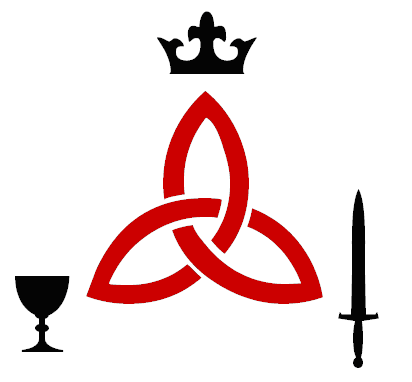 |
The Strategist (Sword) |
Three Archetypes
Philosophy and Magick
The Triquetra is the emblem of our Order. To both members and outsiders, it boldy says Selohaar, appearing on our pendants, banners, rings, documents, and garb. However, the Triquetra is more than just a striking symbol; it also represents the core of Selohaar magickal and philosophical thought in a geometric form. This text shall examine the Triquetra’s symbolism, its role as a mandala for mystical concepts, and its gestural usage in ritual.
In pre-Christian times, the triquetra was a rune of protection and also appeared
in Celtic knotwork. It also probably symbolized eternity, continuity, and infinity.
As Christianity spread, the symbol was appropriated to represent the Holy Trinity
of Father, Son, and Holy Spirit and has made many appearances on Celtic crosses
and in stained-glass church windows. As for Selohaar’s use of this emblem, it
has been associated with the Order since 1982. However, it was not made the
symbol of the Order until 1986. Before that, it was known as the ‘Sigil of Vorthr’
by our members, and symbolized only Vorthr himself, who is nowadays represented
by the winged serpent, the Grunkrae.
|
The Philosopher (Crown)
Word Volnar |
||
|
The Mystic (Grail) |
 |
The Strategist (Sword) |
Three Archetypes
As the accompanying illustration depicts, each point on the triquetra corresponds to one of the elements of the Regalia of the Order: the Sword, Crown, and Grail. Each of these in turn has a corresponding archetype, or aspect of the self, associated with it. They in turn correspond to an entity in our mythos. Hence we can see, using this visual model, how Selohaar magickal and philosophical concepts are really just two different perspectives on the same ideas. Each archetype has its own perception of the world, its own way of addressing problems, and its own mode of thought. Each archetype is detailed in the following lists.
The Strategist -
- Is symbolized by the Sword that wounds or heals
- Explains the external world in terms of cause and effect
- Studies primarily the observable/tangible world
- Uses rationality and logic as its primary mode of thought
- Achieves its goals through physical and mental skills
The Mystic -
- Is symbolized by the Grail and the depths of its vision
- Explains the external world in terms of synchronicity and connectedness
- Studies primarily the subtle/intangible world
- Uses intuition as its primary mode of thought
- Achieves its goals by attuning to natural forces and rhythms
The Philosopher -
- Is symbolized by the Crown and its weight of responsibility
- Explains the external world in terms of personal values and ideals
- Studies primarily the dynamics of the self
- Uses introspection as its primary mode of thought
- Achieves its goals through self-mastery
- Decides what is right, what is wrong, and what must be done
- Seeks to balance the other two archetypes without smothering them
We all have aspects of each of these archetypes within ourselves. It is important that we seek to balance them in our lives. The Self is, therefore, the summation of these three archetypes. Thus we find it in the center of our diagram, at the center of the Triquetra, the point where all three archetypal influences intersect. Thus the Self, the whole individual, uses these archetypes as tools for personal growth and transformation.
It is important here to clarify the elemental associations with the points and center of the Triquetra. These elemental correspondences are somewhat different than others covered in this volume. The Triquetra is a mandala of different aspects of the Self. Therefore, it refers to magickal power and wisdom which come from within. In contrast, when we invoke elemental forces during Circle, we are drawing upon natural, or externalized powers. These are the powers inherent within the environment. As stated elsewhere, Selohaar magick is a uniting of internal, personal power with the forces in nature. The elements, as used with reference to the Triquetra, show us how certain natural rhythms and patterns are present within ourselves. They are a link connecting our inner selves with the world around us. This notion can be summarized by translating the Hermetic Axiom As above, so below into one which more clearly states the relationship between internal and external, or Microcosm and Macrocosm, as perceived by the Order, As without, so within.
The advanced student of Selohaar Gol may detect another set of correspondences regarding the points on the Triquetra. These will only be familiar to the student of the Qabalistic ‘Tree of Life’. In the magickal symbolism of the Tree of Life, the Selohaar Triquetra is an ‘overlay’ on the Supernal Triangle, the first three spheres or Sephira on the tree. The Crown corresponds to Kether, the Sword to Chokmah, and the Grail to Binah. A case may be made for other triangles on the Tree corresponding to the Triquetra, but this would be a topic for the very advanced student and contains some inherent paradoxes regarding the polarities on the Tree’s ‘pillars’ (or lack thereof). At any rate, the relationship between Triquetra and Supernal Triangle is brought to light here so that the student, encountering these similarities in her or his reading travels, will realize that this relationship is by design and continue their inquiry into such matters.
Interaction Between the Archetypes
The interaction of the three archetypes with each other is also worthy of consideration. The Strategist enables the Mystic to be effective; for without strategy, magickal release would be random and undirected. Conversely, the Mystic makes the Strategist more effective. It allows vision and effect to reach beyond the Strategist’s realm, such as into the mind of an opponent. Likewise, the Mystic provides the Philosopher with divined information and intuition to use in decision making, while the Philosopher imparts the qualities of discretion and sound judgement to the Mystic’s intuitive feelings. Lastly, the Strategist allows the Philosopher to manifest its decisions as deeds, while the Philosopher regulates the actions of the Strategist with ethical considerations. If these interactions seem circular in their nature, it is not by accident. The Triquetra is an unbroken line; it represents a continuity between different influences within ourselves.
The Triquetra and the Carcosan Deities
From the diagram, it is apparent that each point on the Triquetra also corresponds to some aspect of divinity in our Carcosan Mythos. These are the familiar primary entities invoked in our magick, Vorthr and Verena, the God and the Goddess. Vorthr is associated with the Sword or Stragetist point, because he represents force and courage. He is the active dispenser of justice, the masculine principle. Verena is the Grail, or Mystic, with its healing, nurturing, and intuitive qualities. It is perhaps more apt to consider these polarities as being projective (Vorthr) and receptive (Verena), rather than as active and passive; for both the God and Goddess possess strength, which just happens to manifest in different ways.
In general, the Crown, or Philosopher, point is not necessarily associated with an entity proper, but rather the balance between the male and female polarities. It is what is between the God and Goddess - it is their bond, their love for each other, and perhaps their child, Volnarr Wol-Tikkan (the crowned and conquering child, perhaps?).
The deities of our mythos reflect the archetypal qualities of the Stragetist, Philosopher, and Mystic. When we invoke these entities in ritual we are summoning forth some aspect of ourselves. To conjure is therefore, from one point of view, to tap into archetypal forces hidden within all of us.
Ritual Application: Invoking and Banishing Gestures
The Triquetra can be easily applied in ritual through gesture by tracing it in the air or upon someone’s person using the hand or a magickal weapon. The clockwise direction of tracing is used to invoke an entity or power, the counter-clockwise direction is used to banish or dismiss that same power. Three forms exist: the General, or Crown Triquetra, the Goddess Triquetra, and the God Triquetra.
For the most general case, we may invoke and banish using the Crown point of the Triquetra. This case is used for magickal operations involving a neutral polarity (neither male or female, projective or receptive), such as invoking the elemental powers at the cardinal points of the Circle or for bestowing general blessings upon a person or thing. To invoke or summon, trace a complete triquetra by starting at the Crown point and moving clockwise from point to point; that is, from Crown to Grail to Sword to Crown. To banish, start at the Crown and work your way around in the counter-clockwise direction.

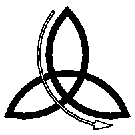
To invoke Verena, use the Goddess Triquetra. To invoke, start at the Grail point and trace clockwise. To dismiss the Goddess, start from this same point and move counter-clockwise.
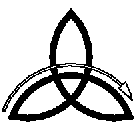
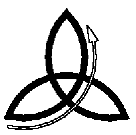
A similar operation is conducted in the summoning of Vorthr, by using the God Triquetra. This is done using the Sword point on the Triquetra.
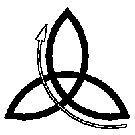
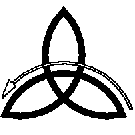
R9612.30